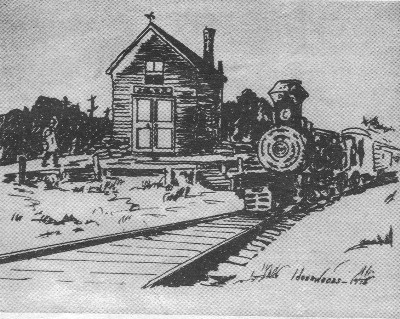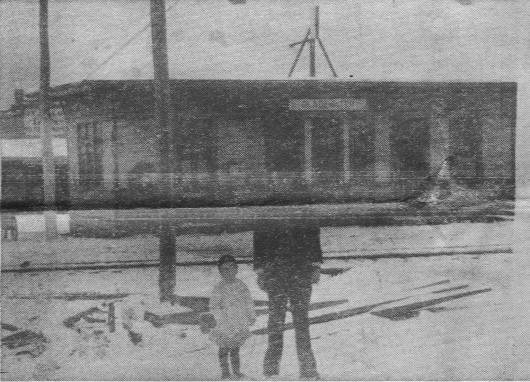 |
|


Drawing by Idona Woods for 1873 train & depot |

1909 Depot with Dr. W.E. Barker and E.E. Martin |
| Gladewater Depot's Destiny By: Dee Harrison This information was taken from the Longview Morning Journal,
Sunday, February 24, 1974, which was found in the vertical files
of the Genealogy Department of the Longview Library. How much history is in an old building? If you are referring to the Gladewater Depot you will probably be told "More than we can tell you about in our lifetime." Yes, with the tearing down of "the old depot" a lot of history and a lot of memories were also torn down. It's difficult for us today to visualize only seven homes between the present city of Longview and Gladewater, yet this was so in 1860. Instead of cars speeding by on modern, four-lane, paved highways, it was a horse-drawn buggy or wagon, dirt roads, and sometimes not more than a narrow trail. As you rode along, you would likely startle a herd of deer grazing or perhaps a flock of wild turkeys feeding along the way. There were no railroads, no super highways, fast cars, and certainly no towns. Just a few small country schools and churches, mostly built from logs and occasionally a simple log cabin. It often meant you rode 15 to 20 miles to get to a post office. The homes had no gas, electricity, telephones, or television. Seldom did they have a buggy and, sometimes, not even a wagon. Then the railroads came, and, with the trains, came growth and expansion. They brought more work, more money, but most of all a link with the rest of the far away world. First, land had to be purchased for right of way. An early newcomer to Gladewater, Jarrett Dean, had purchased 320 acres of land. On December 30, 1872, Dean "conveyed to Texas and Pacific Railway Company for Five Dollars, and for the further consideration that said T&P Railroad Company has located its road through said County of Upshur in such manner as to pass through my lands and have at my instance and request located and cause to be laid off and surveyed a town called Gladewater, situated in part upon my land; said town laid off being situated about one mile East of Camps Ferry over Sabine River........My purpose being to convey to said Company alternate blocks as near as practicable of all portions of said town situated upon my lands." Most of Dean's property was north of the railroad. On January 16, 1973, Anderson White sold to T&P alternate blocks upon all that portion of Gladewater laid upon his land, the greater portion being south of the railroad. So a town was born, a railroad came, and history was made. It was on May 13, 1873, the first trains arrived. The first depot was north of the railroad tracks, close to where the Gladewater Federal Savings and Loan Association Building is now located. It was a small, two story building, with two waiting rooms downstairs, and living quarters for the section foreman and his wife upstairs. Among the first things the new company did was to erect water tanks on Glade Creek, so the engines could "take on" water as they made the trip through the new country. Later, on August 6, 1873, the T&P entered into a contract with the California and Texas Railroad Construction Company to build the line west from Longview to El Paso and on to California. Among the first railroad agents to serve the company were J.H. Honea, W.A. Austin, C. Perriette, and C.V. Rhodes. The "depot" became the meeting place for young and old alike. It was not an unusual sight to see the boys playing marbles. The marble yard was at the east end of the railway station. And, about the only place smooth enough to ride a bicycle was on the railway tracks. Almost any day would find a game of dominoes in progress; and of course, "meeting the train" was a great past time. A passenger train came through shortly after noon and another one later in the afternoon. Youth of the day went there "Kodaking" on a Sunday afternoon following church. Early pioneers involved with the depot were Bart Johnson and his son Dutch, Abram Perry, Rob Thompson, and many others. Today the old depot is torn down. The future? Who knows as preparations for the new modern AMTRAK
come. Will it bring to the new generation the same mystery of
far away places not yet visited, the promise of a new life to
begin somewhere else, or the taking up of the old familiar life
as one returns to those he loves most? Who can know what history
will be written as the next train speeds over its own gleaming
rails, writing its own chapter in a land where history is being
written on the pages of time at an ever-growing rate of speed.
|
Copyright
© 2007 - present by TXGenWeb
(Please read our copyright page
for a better understanding of our copyright needs.)
COPYRIGHT
NOTICE
Materials on this site are provided for the free use of persons who are researching
their family history. Data may be freely used by non-commercial and/or completely
free entities, as long as this message remains on all copied material.
Any commercial use, without the prior consent of the host/author of the materials
provided on this site, is prohibited. The electronic pages on this site may
not be reproduced in any format for profit.
Notice to Webmasters: You may not copy and paste the information on any of the pages of this site onto another web page without first obtaining explicit permission to do so and without including the copyright notice.